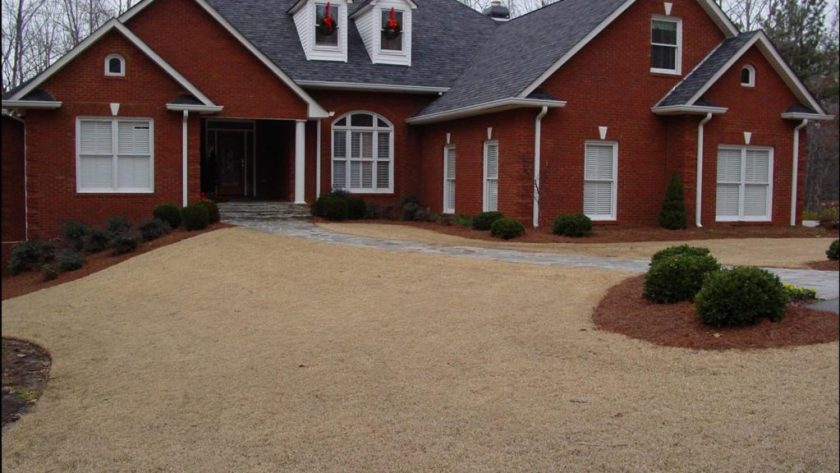Grass turns brown in winter because of the lack of sunlight and lower temperatures that cause the plant to enter a dormant state. During this time, it conserves energy and reduces its metabolic rate, resulting in a change of color.
As the temperatures drop and the days become shorter, grass stops producing chlorophyll, which gives it the green color. Without chlorophyll, other pigments in the plant become more visible, resulting in a change of color. Additionally, the cold temperatures can cause damage to the grass, making it more susceptible to diseases and pests. While the visual aspect of brown grass may be unappealing, it is a natural process that allows the grass to survive the harsh winter months. Understanding why grass turns brown in winter can help us better care for our lawns and ensure that they remain healthy throughout the year.

Credit: sodsolutions.com
Seasonal Changes
During winter, grass turns brown due to seasonal changes. The shorter days and colder temperatures cause the grass to enter a state of dormancy, where growth is slowed. This dormancy period protects the grass from freezing temperatures and snow. As a result, the green chlorophyll pigment in the blades of grass breaks down, leaving behind a brown color.
It’s important to note that not all grass species turn brown in winter. Some warm-season grasses, like bermuda grass, can stay green year-round in regions with mild winter temperatures. Understanding why grass turns brown in winter can help with lawn maintenance and preparation for seasonal changes.
Proper care before and after winter can ensure healthy grass growth when spring arrives.
Lack Of Sunlight
Grass turning brown in winter is primarily due to lack of sunlight. During winter, the days are shorter, and the angle of the sun is lower in the sky. Consequently, the grass receives less sunlight, which is vital for the process of photosynthesis.
Photosynthesis is a biochemical process that enables plants to produce energy from sunlight. Without sufficient sunlight, the grass cannot generate enough energy, and as a result, it turns brown. Additionally, the temperature during winter is generally lower, which slows down the growth rate of grass.
The combination of limited sunlight and low temperature during winter is a significant challenge for the survival of grass. However, with proper maintenance techniques, such as regular irrigation and aeration, the grass can survive the winter and regain its green color.
Why Does My Grass Turn Brown In The Winter?
Freezing Temperatures
During the winter season, grass turns brown due to the freezing temperatures. When the temperature goes below 40°f, the cold air robs the grass of moisture, thereby causing it to lose its vibrant green color. This is because the grass’ roots go dormant, and they stop taking up the nutrients and water from the soil.
As a result, the blades of the grass dry out, and the chlorophyll breaks down, leaving the grass brown and lifeless. However, this does not mean that your grass is dead. Once the temperature rises, your grass will begin to come back to life and regain its green color.
Proper lawn maintenance all year round, including regular watering, mowing, and fertilization, can help minimize winter damage and ensure your grass remains healthy all year.
Lack Of Moisture
Brown grass in winter is due to a lack of moisture. As the temperatures drop, the air becomes drier, leaving the soil with very little water available for the grass to absorb. Additionally, the shorter days and weaker sunlight in winter means less photosynthesis occurs, making it harder for the grass to produce energy.
Frost can also cause damage to the blades of grass, making it harder for them to photosynthesize. In order to prevent grass from turning brown in winter, it is important to provide enough moisture to the soil through watering or by planting drought-resistant grass.
By following these tips, you can ensure that your lawn remains lush and green all year-round.
Insect Infestations
During winter, insect infestations in grass can lead to grass turning brown. Depending on the nature of the infestation, the effects may be moderate or severe. Some insects, like chinch bugs and sod webworms, can cause considerable damage, while others are less harmful.
Chinch bugs, for example, suck sap from grass blades, causing them to turn yellow and dry out. Sod webworms, on the other hand, eat the grass blades entirely, causing patches of brown. Lawn owners can prevent infestations by mowing their lawns slightly high and watering them deeply but infrequently.
They may also treat their lawns with insecticides. By keeping insects at bay, they can ensure their grass stays green throughout the winter.
Conclusion
Overall, it’s clear that grass turning brown in winter is a natural and normal process. While it may not be aesthetically pleasing, it’s important to remember that it’s simply a defense mechanism to protect the grass from harsh winter weather.
However, there are steps you can take to minimize the amount of brown grass in your yard, such as planting cold-resistant grass species or adjusting your watering and fertilization habits. It’s also important to remember that embracing the natural cycle of your lawn can have a positive impact on the environment, as well as reduce the amount of time and money you spend on lawn upkeep.
By understanding and accepting the reasons for grass turning brown in winter, you can approach the colder months with a greater appreciation for the natural world. Remember to take care of your lawn throughout the year, and come springtime, your green grass will be a beautiful sight to behold.




